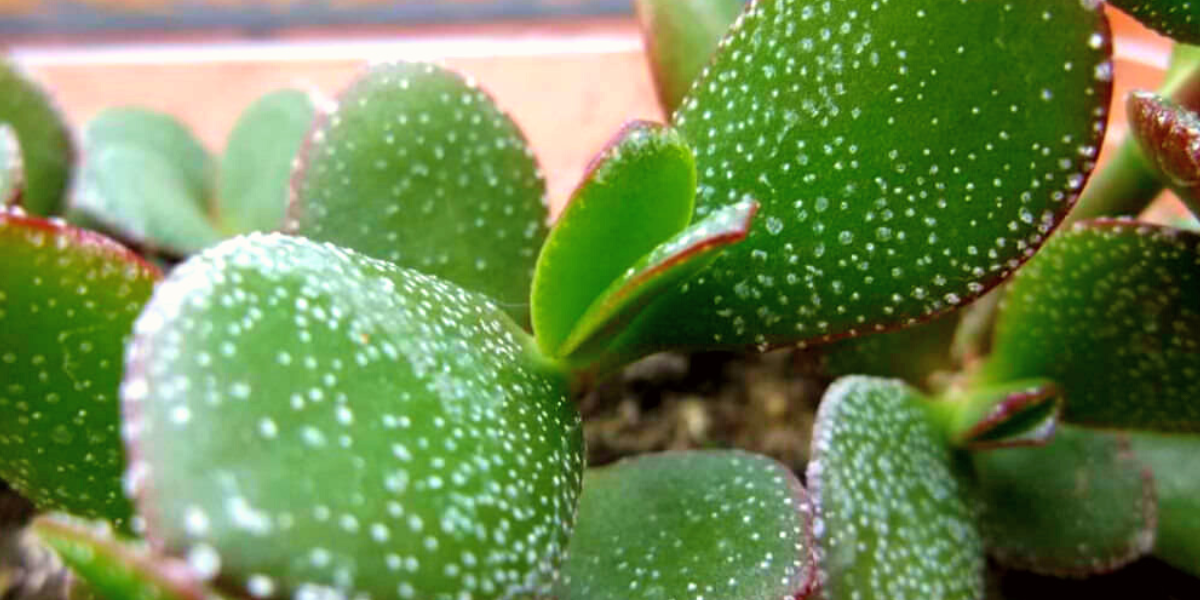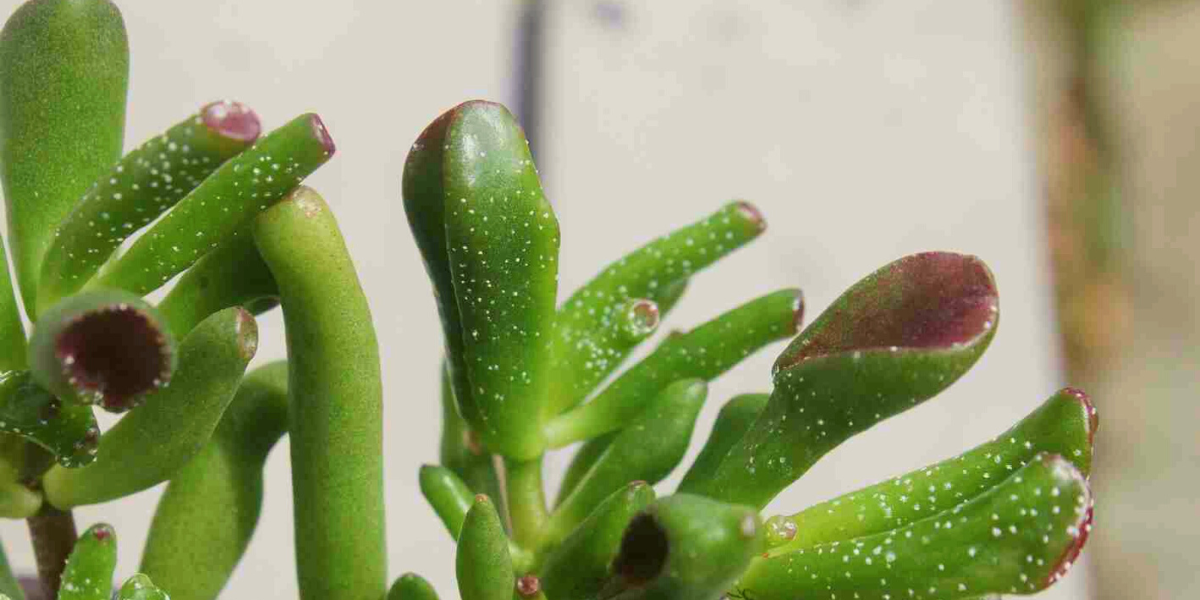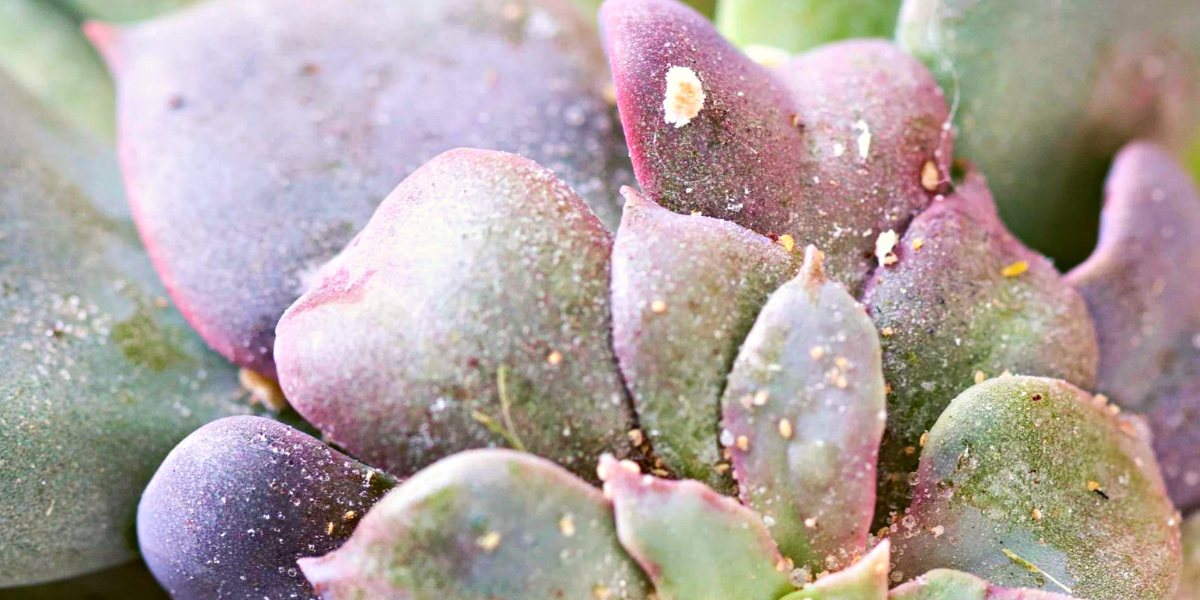The jade plant, also known scientifically as Crassula ovata, has a reputation for being sturdy. It thrives in environments where the majority of plants you see in homes and gardens wouldn’t last for a month, undaunted by neglect or arid conditions. This has been confirmed by its classification by the United States Department of Agriculture, which places it in hardiness zones 9 through 11 out of thirteen. In case you don’t know, this is based on the temperature at which a given plant can lead a healthy floral life.
This might sound like the modest-looking yet cute jade plant should be susceptible to any of the plant diseases that typically plague its pampered greenhouse relatives. Unfortunately, to conclude so would be wrong. Some owners complain of seeing mildew on jade plant leaves and, sometimes, stems. The chances are high that it will look like very fine powder, usually white or off-white, which means it’s one of the most serious jade plant diseases. Affected plants will definitely require extra care as they fight against the infection, in which your best bet would be to aid this combat with natural remedies and possibly harsher methods if they are needed.
This article explains how to diagnose the disfiguring powdery mildew and get the condition under control until it goes too far. Read below to learn about the transmission mechanism of the disease as well as other types of plant mildew it can be confused with.
Background Information
You might hear that the spots your jade plant has developed should be either bacterial or trophic, i.e. related to poor nutrition, in nature. This is far from the truth, however. It turns out there are a number of fungi, that is, microorganisms that belong to a special kingdom other than animals or plants, which use flowers and other flora as their hosts to feed on. Now, you might be wondering what causes such nastiness. The reason is the fungi that do it don’t have any other option as they are obligate biotrophs, the botanical lingo for only being able to feed on plants.

What causes white powder on jade plant leaves?
For those who are interested in the biological aspects of this, there are several types of fungi that cause powdery mildew in jade plants alone. The range is even wider if we include those taking advantage of other plants, in particular roses. Luckily, it doesn’t matter which species you are dealing with in a perennial plant like jade. The knowledge that it’s a pathogen responsible for powdery mildew is more than enough to take appropriate action.
Now that we are aware of the culprit, let’s focus on the risk factors that make some individuals more likely to contract this kind of mould than others. A lot depends on growth conditions. Powdery mildew fungi like humid places where there’s not much light, especially if air circulation is poor. They rely on spores to spread from plant to plant, making an epidemic almost inevitable in closed-door environments such as greenhouses. Such organisms typically need a temperature of 60 to 80 degrees Fahrenheit and a humidity of at least 90 percent to germinate. However, they have the annoying superpower to overwinter in buds, which means cold isn’t a natural remedy to swear by.
What are some causes of mould-like spots on jade plants?
It’s important that you are aware of other conditions that can cause your jade succulent to look like it’s saddled by mildew while it’s not. One of the most common reasons why a jade plant can develop white spots on its leaves is excess salt. You must have noticed that this species has meaty, lush green leaves that seem to be full of juice. Well, they actually are.
Like many succulents, the jade plant relies on its leafy parts to store the water that it gets through its roots. It’s designed to capture any infrequent precipitation as well as ground moisture and store it away in its plump leaves. High salt content is not infrequent in both sources of water, which might cause excess salt to appear on the leaf surface in the form of white spots. This is due to transpiration, when the moisture trapped inside escapes into the environment.
Is powdery mildew harmless?
You might think that the coexistence of your succulent and a fungus doesn’t have to be harmful to the former, but that’s wrong. It’s not what you might describe as an instance of mutual friendship aka symbiosis. Instead, the mould sucks the vital juice and nutrients out of its host, leaving it weak and more susceptible to damage than it was initially. If you pretend like nothing is going on, you’ll likely find the leaves dwarfed and disfigured sooner or later. In particularly dramatic cases, lesions form on the foliage. This damage is mostly irreversible.
Identifying White Fungus Jade Plant White Spots
This part of the article explains the steps to take in case you have spotted suspicious white patches on your plant’s foliage. Follow these to diagnose the problem and determine the measures you need to take to get rid of the defect.
- You can rely on our application to find out what the picture you are observing looks like. It compares the image you have taken with your camera to dozens of similar images to help identify the specific affliction. It’s never a bad idea to double-check the conclusion you have arrived at even if you feel like you can skip this, because the appropriate action for powdery mildew is very different from that for salt spots.
- If still in doubt, try wiping the spots off with a damp cloth. Salt will disappear in no time, while mildew tends to be more stubborn.
- Evaluate the damage if it is a fungal infection. Don’t focus exclusively on the leaves; be sure to check the stem as well. While it’s not a very common scenario, powdery mildew on non-leafy parts is likely to be denser than it normally is. It can look a lot like downy mildew on grapes.
- While powdery mildew is normally white, it can change color as it grows older when left uncontrolled. This is why you might be seeing brown lesions on some leaves, which will likely be badly distorted by that time.
- Be especially careful with the buds, if any. Remember the pathogenic fungus can use nascent flowers to survive through the cold, which means you’ll need to remove them if affected.

If you own more than one jade plant and have spotted signs of powdery mildew, make sure you inspect the others as well. Remember that transmission is quick and easy in the case of these fungi, and there’s no jade species that can be classified as being 100% resistant to it.
I See White Powder on Jade Plant Leaves. What’s Next?
If you have inspected your plant and checked it with our application and it turns out it has powdery mould, leaving it as it is and hoping for the better would be the absolute worst idea that can come to your mind. This is a potentially threatening condition that can undermine the health of a succulent really noticeably unless you help it fight it off. Let’s explore the cures that you can use in order to get rid of this kind of mildew.
Natural treatments
Cultural control, which is the term we use to describe special growing conditions that help manage infestations and diseases, is usually very effective when it comes to powdery mildew on jade plants. Try to ensure conditions that don’t feel too welcoming to the fungus but are good for the succulent itself. This should include the following:
- Planting your jade in sunny places.
- Trimming the foliage regularly to make sure there’s good air circulation.
- Watering the plants in moderation and avoiding overhead watering whenever possible as it can cause the accumulation of water on the surface of individual leaves and thus cause mildew to take root. Alternatively, you can do it when the sun is high and the air is dry since direct application of water destroys mildew. Moderation and control are vital.
- Waiting for the soil to dry completely before you give it any water.
- Watering the succulent at the base rather than misting it.
The measures above should be routine if you want to break the vicious disease cycle once and for all. Mould can be difficult to get rid of because its tiny spores are hard to spot and very sturdy, so it might take some time and a lot of consistency.
If you are looking for a cure that’s effective yet not too harsh on your plants, you can try mixing baking soda with vinegar. Spray what you get on the leaves, but make sure they dry completely or wipe off the remaining moisture to avoid worsening the situation even further. This method is generally viewed as low-damage and low-cost, but it doesn’t have the potency of chemical fungicides.
Anti-mould chemicals
Chemical mould control methods are generally viewed as dubious. Most gardeners won’t consider this option in the context of first-line powdery mildew therapy; however, massive infestations can call for decisive action like this.
When it comes to harsher chemicals than baking soda and vinegar, there are two major approaches to mildew control in jade plants. One option is to use a fungicide, that is, a chemical designed specifically to kill pathogenic fungi. This makes a lot more sense than using toxic substances with a wider range of action as it enables you to minimize damage and maximize your chance for success. It’s still a drastic measure that’s far from being beginner-friendly, though. This is why it’s considered good practice to test whatever agent you are going to use on a small part of the plant first. Any signs of withering or damage such as discoloration should warn you against this product.
If you’ve made the decision to go shopping for a fungicide, pay attention to two factors. First, remember to check whether this or that product works for succulents. Second, make sure it targets powdery mildew specifically. You need a combination of both to swear by it because, as you might remember from the Background Information part of this article, there’s a variety of fungus species that can cause mould.
Some gardeners like to combine fungicides with insecticides for greater effect. Insecticides are chemicals that are meant to kill pest insects, which aren’t rare at all, so it might make sense if you have seen signs of infestation. We recommend that you avoid such mixtures otherwise, though, since no treatment comes at no cost for the plant.

There’s a general trend towards choosing less aggressive chemicals of natural origin in order to preserve the plant as you wage war on the mildew. Neem oil has been all the rage recently as it’s claimed to have everything a gardener could ask for. It’s made of Azadirachta indica, a tree widely used for ornamental purposes and shading across South Asia. The name might ring the bell for you, most likely because you have seen its seeds on the ingredient list in cosmetics such as organic soap. Many people find this fact very comforting because it suggests a reduced risk of damage compared to industrial chemicals.
It’s common to use neem oil as an addition to the soil so that the plant takes it in and distributes it across its tissues. While it is mostly known for its insecticidal properties, this natural remedy is also effective in fighting a variety of mildews, including the powdery type. It’s essential to follow the instructions that come with the given product because different formulations might have different modes of action and possible interactions with the plant can vary.
Keep Your Jade Plant Healthy and Shiny
Powdery mildew is a seriously threatening disease that affects a wide range of plants. Even the notably sturdy jade plant cannot be claimed to be mildew resistant. When dealing with white mould that has the texture of powder, use our specialized app to confirm the diagnosis and evaluate the infestation to work out a treatment plan. Cultural control involving a lot of sunshine and a decent flow of air is both preferable and absolutely necessary, with optional boosters such as fungicide or fungicide+isecticide chemicals as needed.
Have you ever come across fungal plant diseases? Share your experience in overcoming them in the comments section.
Leave a Reply
You must be logged in to post a comment.